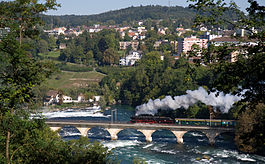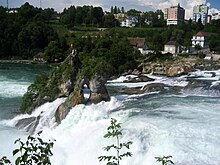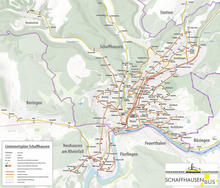
The Rhine Falls is a waterfall located in Switzerland and the most powerful waterfall in Europe. The falls are located on the High Rhine on the border between the cantons of Schaffhausen (SH) and Zürich (ZH), between the municipalities of Neuhausen am Rheinfall (SH) and Laufen-Uhwiesen/Dachsen (ZH), next to the town of Schaffhausen in northern Switzerland.
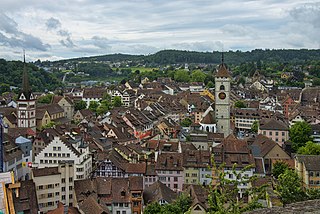
Schaffhausen, historically known in English as Shaffhouse, is a town with historic roots, a municipality in northern Switzerland, and the capital of the canton of the same name; it has an estimated population of 36,000 as of December 2016. It is located right next to the shore of the High Rhine; it is one of four Swiss towns located on the northern side of the Rhine, along with Neuhausen am Rheinfall, the historic Neunkirch, and medieval Stein am Rhein.

The canton of Schaffhausen, also canton of Schaffhouse, is the northernmost canton of Switzerland. The principal city and capital of the canton is Schaffhausen. The canton's territory is divided into three non-contiguous segments, where German territory reaches the Rhine. The large central part, which includes the capital, in turn separates the German exclave of Büsingen am Hochrhein from the rest of Germany.
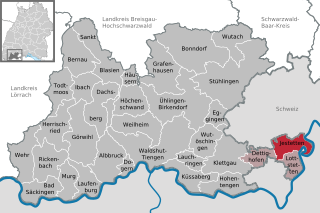
Jestetten is a municipality in the district of Waldshut in Baden-Württemberg in Germany.

Lottstetten is a municipality in the district of Waldshut in Baden-Württemberg in Germany.

The High Rhine Railway is a Deutsche Bahn railway line from Basel Badischer Bahnhof in the city of Basel to Konstanz on Lake Constance. It was built by the Grand Duchy of Baden State Railways as part of the Baden Mainline, which follows the Rhine upstream from Mannheim Hauptbahnhof to Konstanz. The line derives its name from the High Rhine, which it follows between Basel and Waldshut and on a short section in Schaffhausen.
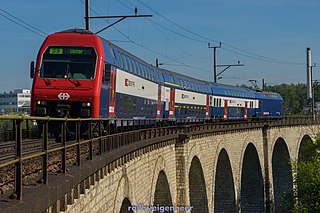
The S9 is a regional railway line of the S-Bahn Zürich on the Zürcher Verkehrsverbund (ZVV), Zürich transportation network, and is one of the network's lines connecting the cantons of Zürich and Schaffhausen in Switzerland. Between the two Swiss cantons, the line also serves two stations in Germany.

Schaffhausen railway station is a railway station in Schaffhausen, the capital of the Swiss canton of Schaffhausen. The station is jointly owned by the Swiss Federal Railways (SBB CFF FFS) and Deutsche Bahn (DB), and is served by trains of both national operators, as well as trains of the Swiss regional operator Thurbo.

Neuhausen is a railway station served by S-Bahn services in the municipality of Neuhausen am Rheinfall, in the Swiss canton of Schaffhausen.

The Rheinfall Railway is a railway line in Switzerland. The line links Winterthur in the canton of Zurich with Schaffhausen in the canton of Schaffhausen. The Rheinfall Railway was constructed by the independent Rheinfallbahn-Gesellschaft.

The Eglisau–Neuhausen railway line is a cross-border railway line in Germany and Switzerland. It links Eglisau in the Swiss canton of Zurich with the city of Schaffhausen in the Swiss canton of Schaffhausen, crossing some 8 kilometres (5.0 mi) of the German state of Baden-Württemberg in between. It thus crosses the Germany–Switzerland border twice. The line is 17.88 kilometres (11.11 mi) long, standard gauge and electrified at 15 kV 16.7 Hz AC supplied by overhead line. It is formed of a mixture of single and double track sections.
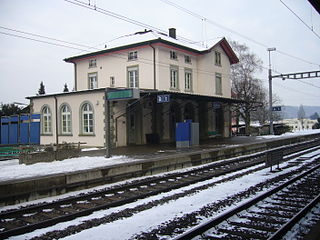
Eglisau railway station is a railway station in the Swiss canton of Zurich and municipality of Eglisau. The station is located on the Winterthur to Koblenz line, at that line's junction with the Eglisau to Neuhausen line. Both lines are owned by Swiss Federal Railways. It is served by Zürich S-Bahn lines S9, between Zürich and Schaffhausen, and S36, between Bülach and Koblenz.
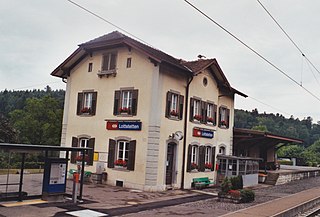
Lottstetten is a railway station in the German state of Baden-Württemberg and municipality of Lottstetten.

Jestetten is a railway station in the German state of Baden-Württemberg and municipality of Jestetten.
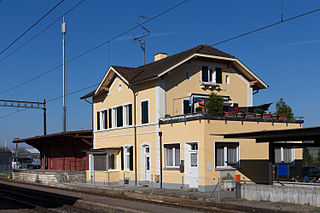
Rafz is a railway station in the Swiss canton of Zürich and municipality of Rafz. The station is located on the Eglisau to Neuhausen line of the Swiss Federal Railway (SBB) that crosses the international border twice on its route between the Swiss cantons of Zürich and Schaffhausen. The station is operated by the SBB and is served by Zurich S-Bahn line S9 that provides a half-hourly service between Zürich and Rafz, with alternate trains continuing to Schaffhausen. Before the timetable revision in late 2015, the station was served by S-Bahn line S5 from Zurich, and an intermediate stop on the S22 between Bülach and Schaffhausen, which was curtailed from Bülach to Jestetten, in turn it no longer fell under the purview of the ZVV.

Thayngen railway station is a railway station in the Swiss canton of Schaffhausen and municipality of Thayngen. Although the station is in Switzerland, it is located on the Deutsche Bahn's High Rhine Railway that links Basel to Singen.

The border between the modern states of Germany and Switzerland extends to 362 kilometres (225 mi), mostly following Lake Constance and the High Rhine, with territories to the north mostly belonging to Germany and territories to the south mainly to Switzerland. Exceptions are the Swiss canton of Schaffhausen, the Rafzerfeld of the canton of Zürich, Bettingen and Riehen municipalities and part of the city of Basel in the canton of Basel-City and the old town of the German city of Konstanz, which is located south of the Seerhein. The canton of Schaffhausen is located almost entirely on the northern side of the High Rhine, with the exception of the southern part of the municipality of Stein am Rhein. The German municipality of Büsingen am Hochrhein is an enclave surrounded by Swiss territory.

Neuhausen Rheinfall is a railway station in Neuhausen am Rheinfall, in the Swiss canton of Schaffhausen. The station opened on 13 December 2015, principally to serve the tourist attraction of the Rhine Falls, from which it takes its name. It is linked by a combination of bridges and elevators to the bank of the River Rhine, just below the waterfall.

Neuhausen Badischer Bahnhof is one of three railway stations in the municipality of Neuhausen am Rheinfall.

The Schaffhausen S-Bahn is an S-Bahn network in the Swiss canton of Schaffhausen and the German state of Baden-Württemberg. It comprises three services and began operation in 2015. Services are operated by SBB GmbH, Swiss Federal Railways' German subsidiary, and THURBO.
